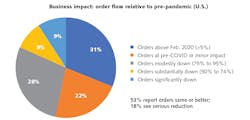SPIE Industry Update: Global photonics trends, outlook, and the impact of COVID-19
A few years ago, the 21st century was often seen as the century of light. In fact, photonics has conquered our daily life: It is the technology that is in the core of a fast internet, and it enables such popular products as smartphones, to name but a few examples. Steve Anderson, Director, Industry Development at SPIE, presented a view of photonics markets that took a wider perspective of photonics as an enabling technology for large parts of our economy. In his systematics, he focuses on the photonics value chain, distinguishing four levels:
- Level 1: Components (e.g., imaging chips, lamps, and lenses)
- Level 2: Photonic products (e.g., imaging subassemblies, displays, and LED lamps)
- Level 3: Enabled products (e.g., smartphones and autonomous vehicles)
- Level 4: Enabled services (e.g., cloud computing, e-commerce, and video streaming)
It is obvious that economic figures derived from these four levels differ severely from the figures for industrial laser markets alone. From 2012 to 2018, the compound average growth rate (CAGR) of the market for photonics components was estimated at 7.6% by Anderson. Earlier in the seminar, laser market analyst Allen Nogee had estimated a CAGR of 13.5% for the pure laser market. That may reflect that Anderson’s statistics includes markets on the order of $200 to 300 billion, compared with a laser-only market size of about $10 to 20 billion. At least on one point, both experts agree: both the laser and the photonics markets are quite healthy, and COVID-19 has done surprisingly little damage to that.
Within his market review, Anderson presented interesting details of the photonics industry. For 2018, he had counted 4298 companies producing photonics components. 52% were located in Asia, while the rest are distributed over America and Europe almost equally. Photonics is widely perceived as a market of small- and medium-sized companies, and the numbers reveal that about 80% of the sector’s revenues are made by 117 companies. The share of the 3075 smallest companies is only 2.5%.
SPIE and the UK-based Photonics Leadership Group conducted three surveys to find out more about the effects of the pandemic on the photonics community (see figure). The surveys revealed that by December 2020, business operations had mostly returned to pre-pandemic levels. In the U.S., 57% of respondents reported being back at pre-COVID levels, and in the UK it was 42%. Another 27% in the U.S. and 35% in the UK reported operating at between 75% and 95% of capacity. Asked for a perspective on 2021, more than 60% were optimistic, expecting increases in new product development, investment, business expansion, and sales during the year. In fact, less than 20% in any category expected things to get worse this year. This fits well with the overall U.S. manufacturing numbers, which recovered at the end of 2020.
In summary, Anderson found most of the photonics business being healthy and growing as it went into the pandemic and it appears to be emerging relatively unscathed. While the immediate outlook for 2021 may be flat to down slightly, there is overarching sense of optimism as we move forward. For companies that were fortunate enough to be able to invest during the pandemic, they may well be able to emerge stronger.
CONTINUE READING >>>
About the Author
Andreas Thoss
Contributing Editor, Germany
Andreas Thoss is the Managing Director of THOSS Media (Berlin) and has many years of experience in photonics-related research, publishing, marketing, and public relations. He worked with John Wiley & Sons until 2010, when he founded THOSS Media. In 2012, he founded the scientific journal Advanced Optical Technologies. His university research focused on ultrashort and ultra-intense laser pulses, and he holds several patents.

